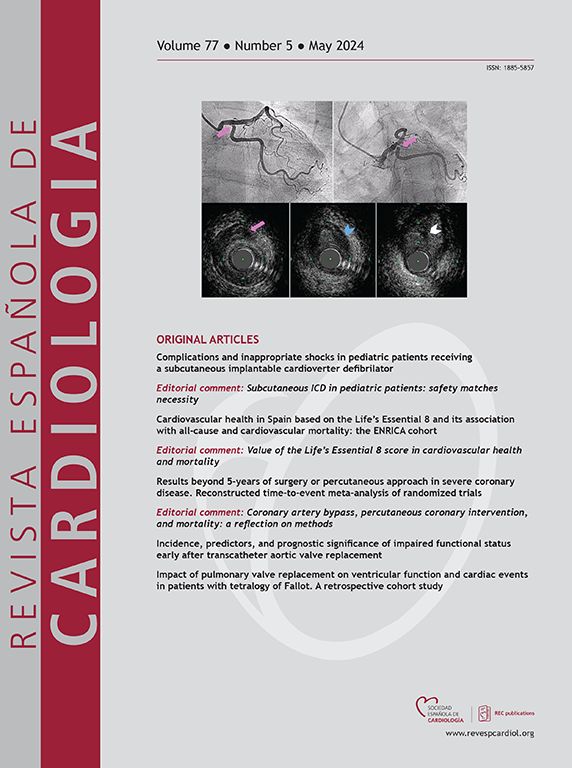通过自动学习和外部验证预测心源性休克患者的医院内死亡率:RESCUE量表
IF 5.9
2区 医学
Q2 Medicine
引用次数: 0
摘要
尽管机械循环支持技术有所进步,但心源性休克(CS)的死亡率仍然很高。一个可靠的风险分层系统可以为CS患者的临床管理提供有价值的指导。本研究旨在利用机器学习(ML)算法开发并外部验证CS患者住院死亡率的风险预测模型。方法分析2014年1月至2018年12月RESCUE登记的1247例全因CS患者的数据。使用4ml算法确定关键预测变量。基于所选变量,采用logistic回归建立了风险预测模型,即RESCUE评分。内部验证在RESCUE注册中心进行,外部验证使用750名患者的独立CS注册中心进行。结果4 ML模型确定了7个预测因素:年龄、血管活性肌力评分、左心室射血分数、乳酸水平、住院时心脏骤停、是否需要持续肾脏替代治疗和机械通气。RESCUE评分显示出很强的预测性能,对院内死亡率的AUC为0.86 (95%CI, 0.83-0.88)。10倍内部交叉验证的AUC为0.86 (95%CI, 0.77-0.95)。外部验证显示AUC为0.80 (95%CI, 0.76-0.84)。结论基于ml的风险评分系统RESCUE评分对所有CS患者的院内死亡率均具有出色的预测效果,无论其原因如何。该系统可作为日常临床实践中评估CS风险分层的有效、可靠的工具。临床试验注册:NCT02985008。本文章由计算机程序翻译,如有差异,请以英文原文为准。
Predicción de la mortalidad intrahospitalaria mediante aprendizaje automático y validación externa en pacientes con shock cardiogénico: la escala RESCUE
Introduction and objectives
Despite advances in mechanical circulatory support, mortality rates in cardiogenic shock (CS) remain high. A reliable risk stratification system could serve as a valuable guide in the clinical management of patients with CS. This study aimed to develop and externally validate a risk prediction model for in-hospital mortality in CS patients using machine learning (ML) algorithms.
Methods
Data from 1247 patients with all-cause CS in the RESCUE registry (January 2014-December 2018) were analyzed. Key predictive variables were identified using 4 ML algorithms. A risk prediction model, the RESCUE score, was developed using logistic regression based on the selected variables. Internal validation was conducted within the RESCUE registry, and external validation was performed using an independent CS registry of 750 patients.
Results
The 4 ML models identified 7 predictors: age, vasoactive inotropic score, left ventricular ejection fraction, lactic acid level, in-hospital cardiac arrest at presentation, need for continuous renal replacement therapy, and mechanical ventilation. The RESCUE score demonstrated strong predictive performance, with an AUC of 0.86 (95%CI, 0.83-0.88) for in-hospital mortality. Ten-fold internal cross-validation yielded an AUC of 0.86 (95%CI, 0.77-0.95). External validation showed an AUC of 0.80 (95%CI, 0.76-0.84).
Conclusions
Our ML-based risk-scoring system, the RESCUE score, demonstrated excellent predictive performance for in-hospital mortality in all patients with CS, regardless of cause. The system could be a useful and reliable tool to estimate risk stratification of CS in everyday clinical practice. Clinical trial registration: NCT02985008.
求助全文
通过发布文献求助,成功后即可免费获取论文全文。
去求助
来源期刊

Revista espanola de cardiologia
医学-心血管系统
CiteScore
4.20
自引率
13.60%
发文量
257
审稿时长
28 days
期刊介绍:
Revista Española de Cardiología, Revista bilingüe científica internacional, dedicada a las enfermedades cardiovasculares, es la publicación oficial de la Sociedad Española de Cardiología.
 求助内容:
求助内容: 应助结果提醒方式:
应助结果提醒方式:


